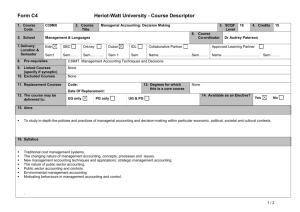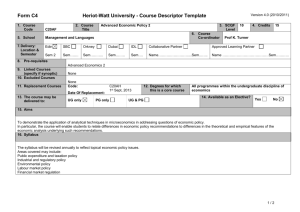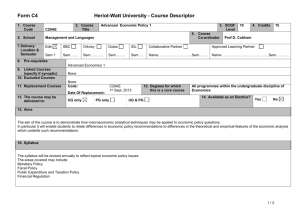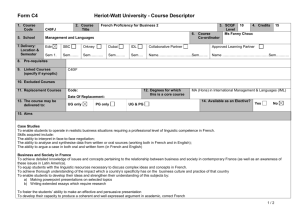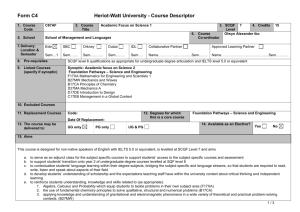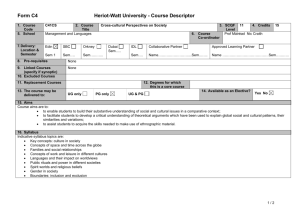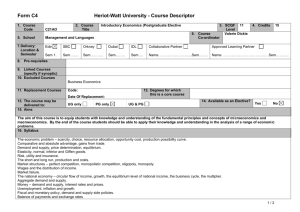B21MT Materials Physics - Heriot
advertisement
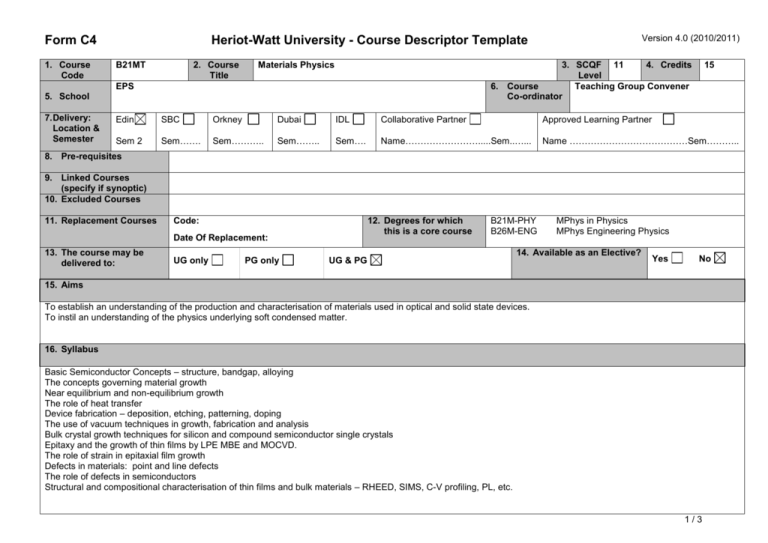
Form C4 1. Course Code B21MT 2. Course Title Materials Physics 3. SCQF 11 4. Credits Level 6. Course Teaching Group Convener Co-ordinator EPS 5. School 7. Delivery: Location & Semester Version 4.0 (2010/2011) Heriot-Watt University - Course Descriptor Template 15 Edin SBC Orkney Dubai IDL Collaborative Partner Approved Learning Partner Sem 2 Sem……. Sem……….. Sem…….. Sem…. Name…………………….....Sem..…... Name …………………………………Sem……….. 8. Pre-requisites 9. Linked Courses (specify if synoptic) 10. Excluded Courses 11. Replacement Courses Code: 12. Degrees for which this is a core course Date Of Replacement: 13. The course may be delivered to: UG only PG only B21M-PHY B26M-ENG UG & PG MPhys in Physics MPhys Engineering Physics 14. Available as an Elective? Yes No 15. Aims To establish an understanding of the production and characterisation of materials used in optical and solid state devices. To instil an understanding of the physics underlying soft condensed matter. 16. Syllabus Basic Semiconductor Concepts – structure, bandgap, alloying The concepts governing material growth Near equilibrium and non-equilibrium growth The role of heat transfer Device fabrication – deposition, etching, patterning, doping The use of vacuum techniques in growth, fabrication and analysis Bulk crystal growth techniques for silicon and compound semiconductor single crystals Epitaxy and the growth of thin films by LPE MBE and MOCVD. The role of strain in epitaxial film growth Defects in materials: point and line defects The role of defects in semiconductors Structural and compositional characterisation of thin films and bulk materials – RHEED, SIMS, C-V profiling, PL, etc. 1/3 Form C4 Version 4.0 (2010/2011) Heriot-Watt University - Course Descriptor Template Introduction to soft materials (forces/energies/timescales/phases) Colloidal dispersions (Stokes Law/Brownian motion, forces between particles) Stability and phase behaviour of colloids Polymers & co-polymers – their nature and applications Review of statistical physics Random walks and the dimensions of polymer chains Static and dynamic conformations Chain statistics – Flory Theorem Scaling concepts in Polymer Physics 17. Learning Outcomes (HWU Core Skills: Employability and Professional Career Readiness) Subject Mastery Understanding, Knowledge and Cognitive Scholarship, Enquiry and Research (Research-Informed Learning) Skills On completion of this module, the learner will be able to: Achieve a critical knowledge and understanding of the connection between physical principles and the generation and application of a vacuum Achieve a critical knowledge and understanding of how materials are produced and characterised by analyses Demonstrate a detailed knowledge and understanding of advanced concepts and applications in device fabrication and characterisation Integrate previous knowledge from the physics course with the topics discussed in the module Apply the theories of vacuum technology and materials physics to problems or situations not previously encountered Understand how the properties of materials depend on their structure and on their fabrication Understand the importance of correlating the formation and processing of materials with their properties and their application Achieve a critical knowledge and understanding of the types of soft condensed matter that exist and their applications Achieve a critical knowledge and understanding of the behaviour of soft condensed matter Apply statistical physics to understand the properties of soft condensed matter Analyse advanced problems in materials physics Personal Abilities Industrial, Commercial & Professional Practice Autonomy, Accountability & Working with Others Communication, Numeracy & ICT Personal abilities are embedded in the module. The module provides the opportunity to : Apply the advanced core knowledge expected of a professional physicist to gain professional level insights, Communicate effectively with professional level colleagues Interpret, use and evaluate critically a wide range of data to solve problems of both a familiar and unfamiliar nature Manage time effectively, work to deadlines and prioritise workloads Use a range of ICT skills with on-line materials and web links to support the learning process Apply strategies for appropriate selection of relevant information from a wide source and large body of knowledge Exercise significant initiative and independence in carrying out learning activities and researching information 18. Assessment Methods Method 19. Re-assessment Methods Duration of Exam (if applicable) Weighting (%) Synoptic courses? Method Duration of Exam (if applicable) 2/3 Diet(s) Form C4 Heriot-Watt University - Course Descriptor Template Written examination 3 hours 100% Version 4.0 (2010/2011) none 20. Date and Version Date of Proposal 21 june 2013 Date of Approval by School Committee Date of Implementation September 2013 Version Number 3/3 v3

